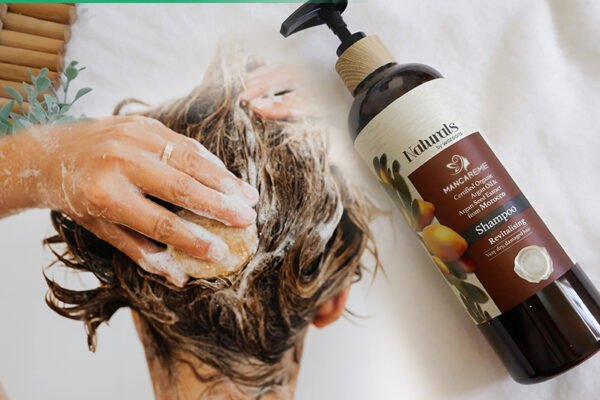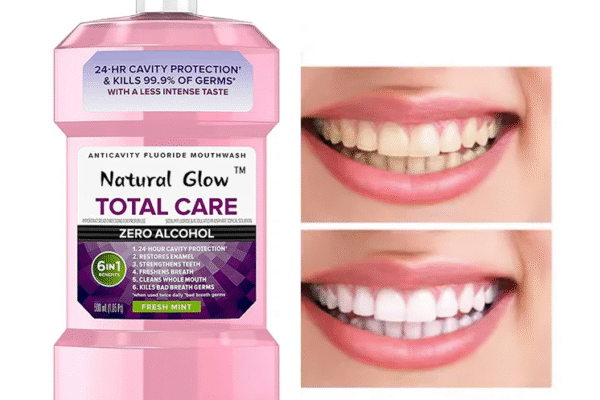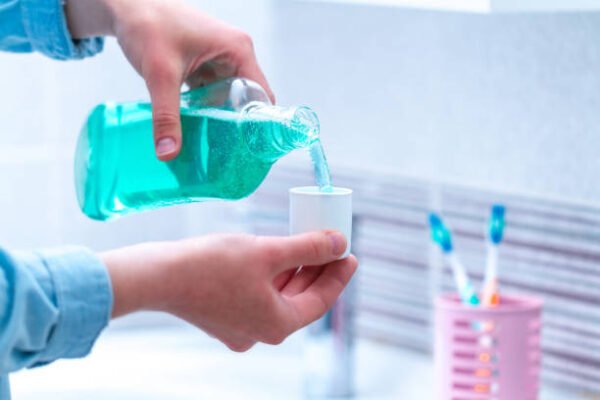You step into the store and you’re probably wondering, “Which type of mouthwash is best?” There are lots of options, all claiming to be good for your teeth, and if you’ve used a mouthwash that did absolutely nothing for you, making a second purchase can be frustrating.
This guide cuts through the noise. Over here, we’re talking simple decision rules, safety heads-ups, and what actually matters according to research and your dentist. You’ll know when to grab a fluoride rinse, when to go for those antiseptic big guns (like chlorhexidine or CPC), and if you need to dodge alcohol-based formulas. And to keep things from getting too overwhelming, we detailed the ingredients that matter and oral care concerns separately, so you’re not standing in the oral care aisle for an hour.
For procurement teams and wholesalers, before you get that retail range or start producing mouthwashes, whether fluoride, natural, or antiseptic, do well to keep your final customers in mind. RuiqiGO is an ODM/OEM mouthwash manufacturer that you can trust to deliver formulations with your buyers in mind. Get in touch, so we can get started on your mouthwash productions, labeling, samples, and lots more.
How to Read the Label – Mouthwash Ingredients That Matter

Below is a list of ingredients you can and should watch out for when choosing a mouthwash for cavities, bad breath, or daily use.
Sodium Fluoride Mouthwash (0.05%)
The active ingredient in this mouthwash is sodium fluoride at about 0.05% (225 ppm), which is the typical strength in over-the-counter rinses. It is recommended as the best mouthwash for cavities as it helps remineralize the enamel and reverse early decay. It also strengthens the teeth and prevents white-spot lesions around brackets. A good number of fluoride mouthwashes are alcohol-free to avoid drying and are approved by dentists for daily use.
Stannous Fluoride Mouthwash
Stannous fluoride is just like sodium fluoride, but with an added antimicrobial effect. It helps to kill bacteria responsible for gum disease. Hence, people with plaque and gingivitis will get more control of their dental issues with stannous fluoride. It is often used intermittently or in special products as an antibacterial mouthwash for people with gingivitis. It can also be prescribed short-term for orthodontic patients to reduce stubborn inflammation. Older SnF₂ mouthwash formulas were known to stain the teeth, so it was often prescribed for a short course. However, new productions can be formulated to reduce staining.
Chlorhexidine Mouthwash
A 0.12% chlorhexidine gluconate mouthwash is the gold-standard for an antiseptic mouthwash. It dramatically reduces plaque and gum inflammation, especially in patients with some dental work and in the first 2 – 6 weeks. With a short period of use, your plaque index and gingival bleeding can drop significantly. It is mostly reserved for use after oral surgery and in cases where brushing might be difficult for 1 – 2 weeks, to reduce infection and dry socket. Like stannous fluoride, a CHX rinse can stain the teeth/brackets, build up calculus, and alter taste; therefore not advisable for more than 4 weeks of use.
Cetylpyridinium Chloride (CPC) Mouthwash
A cetylpyridinium chloride (CPC) mouthwash typically contains 0.05 – 0.075% of cetylpyridinium chloride, and it is a mild antimicrobial antiseptic. This is one of the best mouthwash for bad breath as it can significantly reduce the sulfur compounds that cause bad breath (halitosis). It also helps reduce your plaque and gingivitis scores. Overall, it is good for everyday use by people with halitosis and plaque buildup. Plus, they are usually alcohol-free and gentle, so they won’t dry out the mouth. Most mouthwashes containing CPC are often combined with fluoride for extra anticavity and antibacterial effects.
Essential Oil Mouthwash
The actives in essential oil mouthwashes are plant-based antiseptics like eucalyptol, menthol, or thymol. They are known for their broad antimicrobial effects and for reducing gingival bleeding and plaque over time. This mouthwash for gum disease can be used daily and is available in both alcohol-based and alcohol-free options. Orthodontic patients can use an essential oil mouthwash to keep their gums healthy under their brackets.
Xylitol Mouthwash / Dry-mouth rinses
Xylitol is a sugar alcohol, and the mouthwash contains this, as well as other moisturizing agents. Since the bacteria that cause oral decay (Streptococcus mutans) cannot metabolize xylitol, this alcohol starves the bacteria, reduces acid production, and prevents the bacteria from attaching to the teeth, thereby preventing cavities. Hence, it qualifies as one of the best mouthwash for cavities. As a mouthwash for dry mouth, xylitol also stimulates saliva flow and is often recommended in products for xerostomia.
Antiseptic vs Natural vs Fluoride Mouthwashes – Which to Pick

The best mouthwash for cavities, dry mouth, or gum disease, among others, largely depends on the particular dental concerns that you are targeting. Maybe you want a mouthwash to prevent white spots in braces or a cosmetic rinse to mask odors and taste good. The truth is, you won’t solve these issues if you’re not choosing the right mouthwash depending on your specific needs. Below are the major differences between the common mouthwashes and when to use each:
Cosmetic Mouthwash (Fresh-Breath Rinses):
Like the name implies, your goal is just a quick breath boost. You know those minty rinses you can swish after coffee, garlic-heavy meals, or before a meeting for immediate freshness? This is it. They usually contain flavors, mild antimicrobials (like cetylpyridinium chloride or zinc), or oxygenating agents to mask the bad breath. Although a cosmetic mouthwash is considered one of the best mouthwash for bad breath, it will not kill odor-causing bacteria long-term. Yes, they are handy for bad breath emergencies, but if the root cause is a gum or decay issue, cosmetic rinses can’t fix it.
Antiseptic Mouthwash (Therapeutic Rinses):
Got gum issues or just had dental work? An antiseptic mouthwash is a good choice. They contain strong antibacterials like chlorhexidine or essential oils, and your dentist would likely hand you a bottle after extractions, implants, or deep cleanings. A chlorhexidine mouthwash does wonders post-surgery. It cuts down your risk of dry socket and keeps infections at bay. Likewise, essential oil mouthwashes such as eucalyptol or menthol help reduce plaque and gingivitis, especially when used with brushing. One thing to note about the chlorhexidine mouthwash for gum disease is that it is best used short-term (usually 1 – 2 weeks) as directed, since long-term use can stain the teeth or alter taste. Whereas essential oil rinses can be used long-term alongside brushing.
Fluoride Mouthwash (Strengthening Rinses):
The best mouthwash that will keep you safe from cavities and remineralize your enamel is a fluoride mouthwash. They typically contain sodium or stannous fluoride. When used regularly, it can help rebuild weak spots in your enamel and guard against decay. For children prone to cavities or adults with receding gums, a nightly rinse with a 0.05 – 0.2% fluoride solution is often advised. You may also see health authorities note that “using a mouthwash that contains fluoride can help prevent tooth decay”, and from decades of research, that is true. This mouthwash for cavities is also useful if your local water isn’t fluoridated or if you have dry mouth (low saliva), since “lack of saliva increases the risk of caries” and fluoride rinses can compensate. Bonus Tip: Don’t go rinsing with a fluoride wash right after you brush. Give it like half an hour, let the toothpaste do its thing. Otherwise, what’s the point?
Natural Mouthwash (Herbal Rinses):
These mouthwash contain plant-based extracts like aloe vera, tea tree, peppermint, or green tea. They are often gentle on the gums, “chemical-free”, and contain natural antimicrobials or anti-inflammatories. Research shows that some natural rinses work almost as well as medicated ones. For instance, an aloe vera mouthwash was found to be equally effective as chlorhexidine in reducing plaque and gingivitis. Likewise, essential oil formulas (mint, tea tree, etc.) can significantly reduce gum inflammation. You can use a natural mouthwash every day to soothe sensitive gums and mildly freshen your breath. They tend to be gentler (so fewer side effects); however, their therapeutic power is less than a prescription mouthwash, especially if you’re dealing with serious infections. Overall, a natural mouthwash can complement brushing if you have mild gingivitis or prefer holistic care.
Bottom Line: Which type of mouthwash is best?
The simple answer — Match the rinse to your mouth’s needs.
-
- Bad breath only ⇒ cosmetic rinse or a minty “natural” mouthwash
-
- Gum disease or post-op healing ⇒ antiseptic mouthwash
-
- Frequent cavities, weak enamel, or dry mouth ⇒ fluoride mouthwash
-
- Daily gentle boost with fewer chemicals ⇒ natural herbal mouthwash
Safety Tips & Contraindications for Using a Mouthwash

-
- Chlorhexidine: Only use a chlorhexidine mouthwash for as long as your dentist tells you (typically 1 – 2 weeks). It can cause teeth staining and taste change. However, brushing and professional cleanings are your best defense against the stains. And if you quit using the mouthwash, those pesky brown marks usually fade away. If you use chlorhexidine long-term, those extra stains could turn into tartar. So if you need a mouthwash to use long-term, discuss with your dentist for other options.
-
- Alcohol: Mouthwashes with loads of alcohol can dry out your mouth and irritate your gums. If you already have dry mouth or sensitive gums, you should grab an alcohol-free one. Also, many clinicians advise avoiding alcohol mouthwashes during pregnancy. Pick alcohol-free options and check with your care provider.
-
- Fluoride rinses: Most fluoride mouthwashes are for older children and adults, and are usually not recommended for young children <6 (to avoid swallowing). Supervise use and follow the dentist’s age guidance. If you’re thinking about giving mouthwash to little kids (under six), definitely ask the dentist.
-
- Allergies and sensitivities: If your mouth reacts to flavors, essential oils, or random chemicals in rinses, stop using them and look for something made for sensitive types. Some mouthwashes can stain or mess with dental works like temps or soft liners. If you wear any kind of prosthetic, double-check with your dentist before swishing.
-
- General rule: Mouthwash should be an add-on, not a replacement for brushing and flossing. If you’re lost at any point, just ask your dentist.
Best Practices for Mouthwash Usage

If you have X, avoid Y
-
- Sensitive gums → Skip high alcohol mouthwashes.
-
- Aligners or clear trays → Stay away from colored or high alcohol mouthwashes; and take the trays out first.
-
- Long-term gingivitis → Don’t use chlorhexidine for long.
-
- Young children who swallow everything → Avoid fluoride mouthwashes unless the dentist gives a go-ahead and you keep an eye on them.
Tips for Oral Hygiene
-
- Is fluoride mouthwash necessary?
A fluoride mouthwash is not necessary for everyone. However, it is helpful if you have a high risk for cavities, tooth decay, or receding gums. To be clear, ask your dentist about concentration and age guidance.
-
- Should I avoid alcohol mouthwash?
Not unless your dentist says so. But if your mouth dries out a lot, you have sensitive gums, you’re pregnant, or you wear aligners, you should go for alcohol-free mouthwashes.
-
- How often should I use mouthwash?
Most “therapeutic” rinses are a once or twice a day thing, and you can use cosmetic rinses as often as you need them. However, you should read the label and follow the product directions.
-
- Should I rinse right after brushing?
No, you should not rinse vigorously right after brushing with fluoride toothpaste. Waiting ~30 minutes helps fluoride work better.
-
- Final tip:
Buy by goal, not marketing. Match the active ingredient to your dental issues, and check with your dentist for mouthwashes that require clinical supervision.
Conclusion
The right mouthwash for you starts with a clear goal: fresh breath, fewer cavities, or healthier gums. Cosmetic mouthwashes work for quick freshness. Therapeutic mouthwashes treat problems like active gum disease or post-op healing. Fluoride mouthwashes are the choice when cavity prevention or enamel repair is the priority. If you have dry mouth or just hate the burn that comes with alcohol mouthwashes, go for something alcohol-free or natural. Don’t forget to actually read the label and use it how you’re supposed to. If you need more guidance, just ask your dentist.
For clinics, retailers, and procurement teams, always match what you’re buying/producing to what your patients actually need. Also, ask for samples and try them out before completing your order. Feel free to contact RuiqiGO to start manufacturing toothpastes and mouthwashes that meet your buyers’ needs and clinical expectations. Our team can help out with all the information you need on formulation, sample kits for evaluation, labeling, and lots more.
FAQ
Which mouthwash is best for gum disease?
Antiseptic mouthwashes work best for gum disease. Think chlorhexidine used short-term or daily CPC/EO formulas to reduce gingivitis. Use them with brushing, flossing, and your dentist’s guidance.
Is alcohol mouthwash bad?
Not always, but it can be bad for you if your mouth is already dry or sensitive. If you’re pregnant, have dry mouth, or wear aligners, skip them and get alcohol-free options.
Can mouthwash replace brushing?
No, mouthwash helps, but it’s not a substitute for actual brushing and flossing, since it does not remove plaque as effectively.
Which mouthwash is safe during pregnancy?
Stick with alcohol-free or super mild mouthwashes like a saline or xylitol mouthwash. Avoid strong medicated rinses unless your provider approves. Always check with your obstetrician if you’re concerned at any point.
How long should I use chlorhexidine mouthwash?
Typically, you should use a chlorhexidine mouthwash for just a week or two, unless your dentist advises otherwise. Any longer and you risk getting stained teeth and a change in taste.







